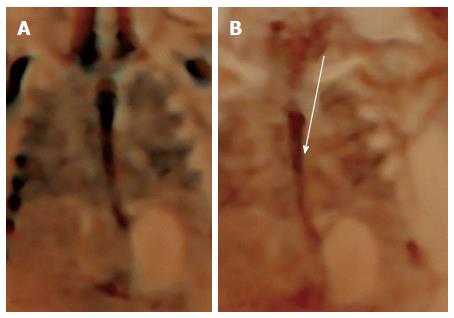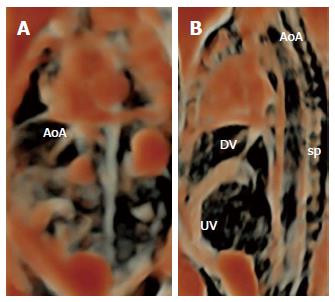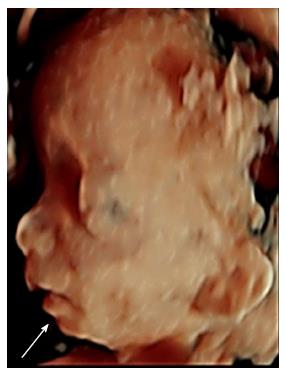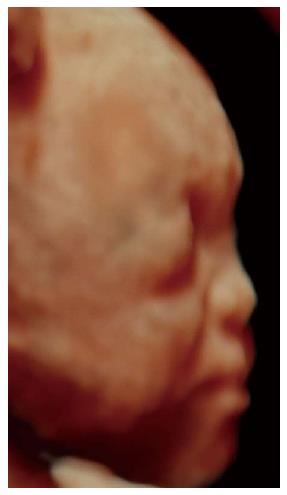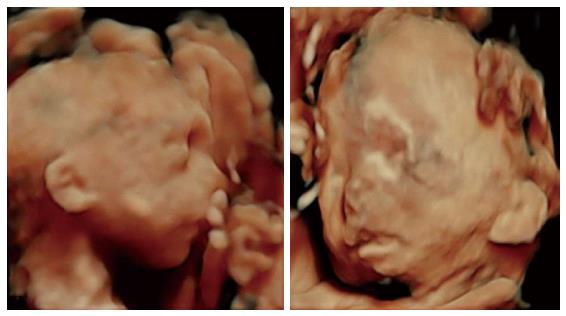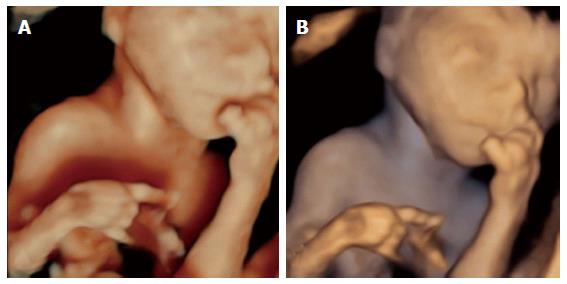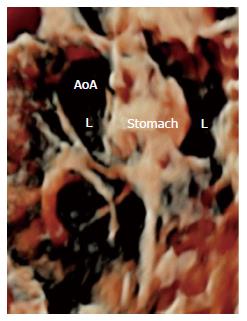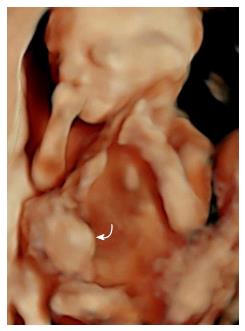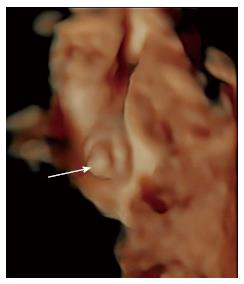Copyright
©The Author(s) 2016.
World J Radiol. Dec 28, 2016; 8(12): 922-927
Published online Dec 28, 2016. doi: 10.4329/wjr.v8.i12.922
Published online Dec 28, 2016. doi: 10.4329/wjr.v8.i12.922
Figure 1 Normal fetal brain at 28 wk of gestation.
A: 4DUS using HDliveTM shows, with impressive image quality resembling that of gross anatomy, the cerebral cortex (ccx), the corpus callosum (cc), the cavum septum pellucidum (csp), the thalamus (th) and brainstem (bs) in mid-sagittal plane; B: The same images using the conventional 3DUS in the rendering mode.
Figure 2 Normal fetal esophagus at 28 wk of gestation.
A and B: 4DUS using HDliveTM application may be used to obtain a clear imaging of inner structure of esophagus (arrow) during fetal swallowing at the time of routine second trimester scan.
Figure 3 Normal fetal aortic arch at 28 wk of gestation.
4DUS echocardioangiography using HDliveTM application to the study of the great artery and veins: the AoA (A, image is rotated), the UV and the DV (B) are rendered with an enhanced quality resembling that of an angiographic study (sp, fetal spine). AoA: Aortic arch; UV: Umbilical vein; DV: Ductus venosus; sp: Fetal spine.
Figure 4 4DUS using HliveTM (5DUS) lightening technique: Realistic rendering in a case (A) of left-sided cleft lip and palate and left-sided cleft lip (B).
C and D: The same images using the conventional 3DUS in the rendering mode.
Figure 5 4DUS using HliveTM showing the right-sided cleft lip and palate (arrow) in a fetus with 21 wk-3 d.
Figure 6 4DUS using HDliveTM: Micrognathia (arrow) is clearly rendered.
Figure 7 4DUS using HDliveTM showing a hypoplastic face.
Figure 8 4DUS using HDliveTM enabled a clear snapshot of low-set ears in this case detected at 24 wk of gestation.
Figure 9 Arthrogryposis multiplex congenital.
A: 4DUS using HDliveTM, note the characteristic muscular contractions causing fingers deviation; B: The same using the conventional 3DUS in the rendering mode.
Figure 10 4DUS using HDliveTM application in a case of left congenital diaphragmatic hernia.
AoA: Aortic arch; L: Lung.
Figure 11 4DUS using HDliveTM application in a fetus with exomphalos (curved arrow) was diagnosed at early second trimester scan (15 wk-3 d).
Figure 12 4DUS using HDliveTM application in a case of clitoris hypertrophy (arrow) detected at 27 wk of gestation in an intersexual state (postnatal chromosomal assessment resulted in 46,XY karyotype).
- Citation: Tonni G, Grisolia G, Santana EF, Júnior EA. Assessment of fetus during second trimester ultrasonography using HDlive software: What is its real application in the obstetrics clinical practice? World J Radiol 2016; 8(12): 922-927
- URL: https://www.wjgnet.com/1949-8470/full/v8/i12/922.htm
- DOI: https://dx.doi.org/10.4329/wjr.v8.i12.922










